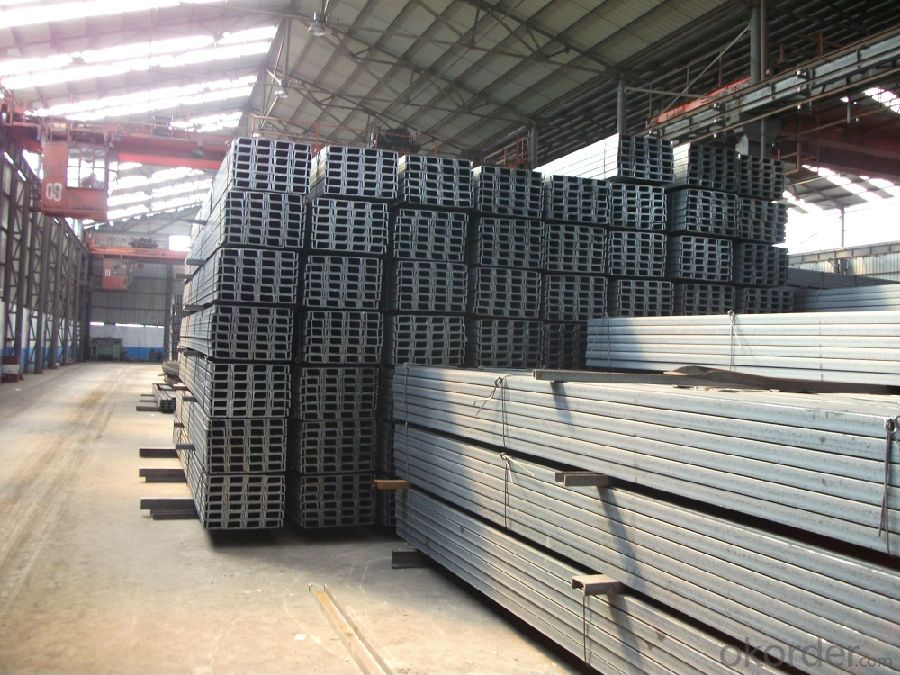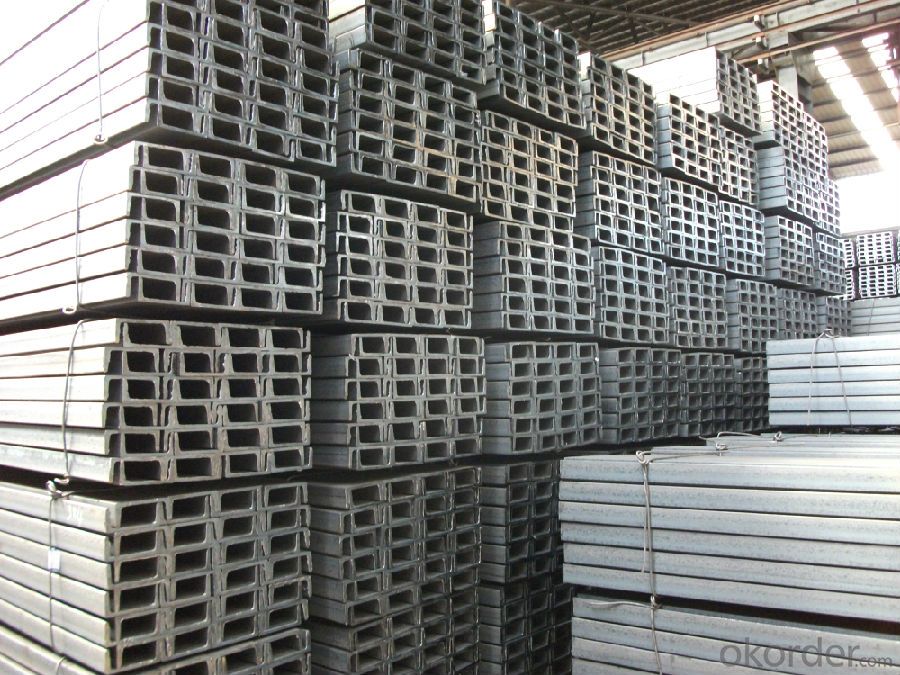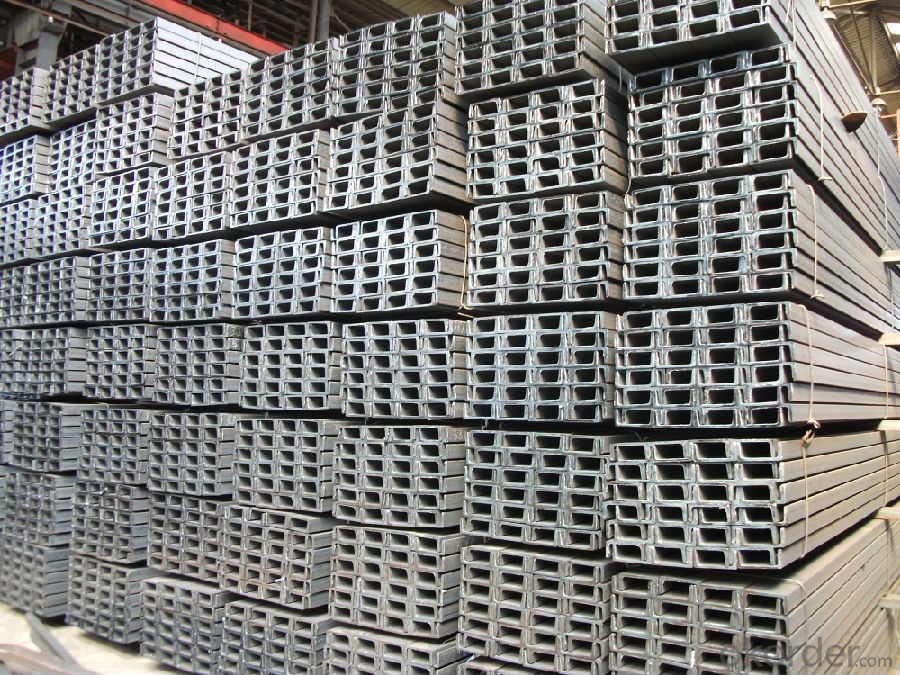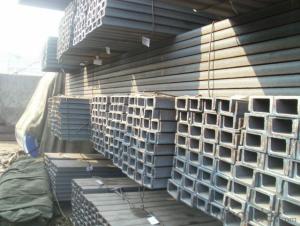U Channel Hot Rolled Steel Made In China GB JIS EN DIN
- Loading Port:
- Tianjin
- Payment Terms:
- TT OR LC
- Min Order Qty:
- 50 m.t.
- Supply Capability:
- 40000 m.t./month
OKorder Service Pledge
OKorder Financial Service
You Might Also Like
Item specifice
Product Description:
OKorder is offering U Channel Hot Rolled Steel Made In China GB JIS EN DIN at great prices with worldwide shipping. Our supplier is a world-class manufacturer of steel, with our products utilized the world over. OKorder annually supplies products to European, North American and Asian markets. We provide quotations within 24 hours of receiving an inquiry and guarantee competitive prices.
Product Applications:
U Channel Hot Rolled Steel Made In China GB JIS EN DIN are ideal for structural applications and are widely used in the construction of buildings and bridges, and the manufacturing, petrochemical, and transportation industries.
Product Advantages:
OKorder's U Channel Hot Rolled Steel Made In China GB JIS EN DIN are durable, strong, and resist corrosion.
Main Product Features:
· Premium quality
· Prompt delivery & seaworthy packing (30 days after receiving deposit)
· Corrosion resistance
· Can be recycled and reused
· Mill test certification
· Professional Service
· Competitive pricing
Product Specifications:
Standard Applied: GB Standard, EN Standard(UPN), JIS Standard
Sizes: 50mm to 300mm
Material Grade: Q235B, Q345B, S235JR, SS400, ASTM A36
As shown in the figure:
JIS U CHANNEL | Standard h | Sectional b | Dimension s | t | Mass: Kg/m |
(mm) | (mm) | (mm) | (mm) | ||
50x25 | 50 | 25 | 3.0 | 6.00 | 2.37 |
75X40 | 75 | 40 | 3.8 | 7.00 | 5.30 |
75X40 | 75 | 40 | 4.0 | 7.00 | 5.60 |
75X40 | 75 | 40 | 4.5 | 7.00 | 5.85 |
75X40 | 75 | 40 | 5.0 | 7.00 | 6.92 |
100X50 | 100 | 50 | 3.8 | 6.00 | 7.30 |
100X50 | 100 | 50 | 4.2 | 6.00 | 8.03 |
100X50 | 100 | 50 | 4.5 | 7.50 | 8.97 |
100X50 | 100 | 50 | 5.0 | 7.50 | 9.36 |
125X65 | 125 | 65 | 5.2 | 6.80 | 11.66 |
125X65 | 125 | 65 | 5.3 | 6.80 | 12.17 |
125X65 | 125 | 65 | 5.5 | 8.00 | 12.91 |
125X65 | 125 | 65 | 6.0 | 8.00 | 13.40 |
150x75 | 150 | 75 | 5.5 | 7.30 | 14.66 |
150x75 | 150 | 75 | 5.7 | 10.00 | 16.71 |
150x75 | 150 | 75 | 6.0 | 10.00 | 17.90 |
150x75 | 150 | 75 | 6.5 | 10.00 | 18.60 |
1.We are able to provide channel steel of top quality at attractive price.
2.Our products of channel steel have passed ISO9001:2008 Quality Management System Certification.
Package & Delivery of Channel Steel:
The steel u channel will be packed in bundle with steel wire at each end of every bundle and color marking in order to help the customer to recognize his goods more easily at sight.
And steel u channel could be loaded into 20ft or 40ft container, or by bulk cargo. If the weight of each bundle reaches less than 3.5 mt, the loading by break bulk cargo should be choosed. When the weight of each bundle reaches less than 3mt, the loading by container should be choosed.
As for the transportaion from mill to loading port, the truck will be usually used. And the maximum quantity for each truck is 40mt.
All in all, we could do in accordance with customer's request.
FAQ:
Q1: Why buy Materials & Equipment from OKorder.com?
A1: All products offered byOKorder.com are carefully selected from China's most reliable manufacturing enterprises. Through its ISO certifications, OKorder.com adheres to the highest standards and a commitment to supply chain safety and customer satisfaction.
Q2: How do we guarantee the quality of our products?
A2: We have established an advanced quality management system which conducts strict quality tests at every step, from raw materials to the final product. At the same time, we provide extensive follow-up service assurances as required.
Q3: How soon can we receive the product after purchase?
A3: Within three days of placing an order, we will begin production. The specific shipping date is dependent upon international and government factors, but is typically 7 to 10 workdays.
Q4: What makes stainless steel stainless?
A4: Stainless steel must contain at least 10.5 % chromium. It is this element that reacts with the oxygen in the air to form a complex chrome-oxide surface layer that is invisible but strong enough to prevent further oxygen from "staining" (rusting) the surface. Higher levels of chromium and the addition of other alloying elements such as nickel and molybdenum enhance this surface layer and improve the corrosion resistance of the stainless material.
Q5: Can stainless steel rust?
A5: Stainless does not "rust" as you think of regular steel rusting with a red oxide on the surface that flakes off. If you see red rust it is probably due to some iron particles that have contaminated the surface of the stainless steel and it is these iron particles that are rusting. Look at the source of the rusting and see if you can remove it from the surface.
Images:



- Q:Can steel channels be used for railway tracks?
- Railway tracks cannot be made using steel channels. Instead, a specific type of steel known as "rail steel" or "railroad steel" is required. This type of steel is specifically designed and manufactured to meet the demands of constructing railway tracks. Rail steel possesses certain properties that enable it to endure the heavy loads, constant stress, and wear and tear that railway tracks experience. It undergoes a specialized manufacturing process and has a predetermined chemical composition to guarantee its durability and strength. On the contrary, steel channels are not built to withstand the same level of stress and wear as rail steel. Consequently, they would quickly deteriorate when exposed to the heavy loads and continuous movement of trains. Therefore, the utilization of rail steel is crucial for the construction of railway tracks in order to ensure the safety and efficiency of the rail system.
- Q:Can steel channels be used in bridge construction?
- Yes, steel channels can be commonly used in bridge construction. Steel channels are structural components made of steel that have a C-shaped cross-section. They offer high strength, durability, and versatility, making them suitable for various applications in bridge construction. Steel channels are often used as beams or supports in bridge construction because of their ability to withstand heavy loads and provide structural stability. They can be used as primary load-bearing members or secondary components to support other bridge elements. The use of steel channels in bridge construction offers several advantages. Firstly, steel channels have excellent strength-to-weight ratio, meaning they can provide high load-carrying capacity while being relatively lightweight. This results in cost savings during construction and reduces the overall weight of the bridge, leading to more efficient designs. Secondly, steel channels are resistant to corrosion, which is crucial for bridges exposed to harsh environmental conditions, such as bridges built near saltwater or in areas with high humidity. Steel channels can be galvanized or coated with protective layers to enhance their resistance to corrosion, ensuring the longevity and durability of the bridge structure. Furthermore, steel channels can be easily fabricated and customized to meet specific design requirements. They can be cut, welded, and shaped into various lengths and sizes to fit the bridge design. This flexibility allows engineers to create complex bridge structures that are both strong and aesthetically pleasing. In conclusion, steel channels are a commonly used component in bridge construction due to their strength, durability, and versatility. They provide structural stability, high load-carrying capacity, resistance to corrosion, and cost-effective solutions for bridge designs.
- Q:Six meters long, standard 10 channel steel, theoretical weight
- Channel steel is a kind of carbon structural steel used for construction and machinery. It is a complex section steel. Its cross section has a groove shape. Channel steel is mainly used in building structure, curtain wall engineering, mechanical equipment and vehicle manufacturing, etc.. In use, it requires better welding, riveting performance and comprehensive mechanical properties. The raw material steel billet for channel steel is carbon or low alloy steel billets with a carbon content of not more than 0.25%.
- Q:According to the standard, indoor hanging stone 3 meters high, whether to add channel?
- The most necessary to use the channel skeleton, hanging directly on the wall is not safe
- Q:How can channel A and B be distinguished?
- Grade a do not do impact test, B do, B quality is better than A, general bad steel above will have labels
- Q:What are the different types of connections used for steel channels in bridges?
- There are several different types of connections used for steel channels in bridges, including bolted connections, welded connections, and hybrid connections. Bolted connections involve using bolts to connect the channels together, providing a strong and easily adjustable connection. Welded connections involve fusing the channels together using heat, resulting in a permanent and continuous connection. Hybrid connections combine both bolted and welded connections, utilizing the benefits of both methods to create a secure and efficient connection. The choice of connection type depends on factors such as the bridge design, load requirements, and construction constraints.
- Q:How do steel channels contribute to sustainable design?
- Steel channels contribute to sustainable design in several ways. Firstly, steel channels are made from recycled materials. Steel is one of the most recycled materials in the world, with a high percentage of steel being made from recycled scrap. This reduces the demand for raw materials and energy consumption in the production process, thereby reducing the carbon footprint. Secondly, steel channels have a long lifespan. Steel is a highly durable material that can withstand extreme weather conditions and resist corrosion. This means that steel channels require less maintenance and replacement over time, reducing the need for frequent repairs and replacements. This not only saves resources but also reduces the waste generated from construction and demolition activities. Thirdly, steel channels are lightweight and versatile. This allows for efficient transportation and installation, which reduces fuel consumption and associated emissions. Additionally, the versatility of steel channels enables them to be easily reused or repurposed in other projects, extending their lifecycle and minimizing waste. Furthermore, steel channels offer design flexibility. The strength and structural integrity of steel allow for innovative and efficient designs, such as open floor plans and large spans, which can maximize natural lighting and ventilation. This reduces the need for artificial lighting, heating, and cooling, resulting in lower energy consumption and reduced greenhouse gas emissions. Lastly, steel channels are recyclable at the end of their lifespan. Steel is 100% recyclable and can be reused indefinitely without losing its quality. This not only conserves natural resources but also reduces the amount of waste sent to landfills. In conclusion, steel channels contribute to sustainable design by being made from recycled materials, having a long lifespan, being lightweight and versatile, offering design flexibility, and being recyclable. These features help reduce the environmental impact of construction projects and promote a more sustainable built environment.
- Q:Can steel channels be used in high-temperature environments?
- Yes, steel channels can be used in high-temperature environments. Steel has excellent heat resistance properties and can withstand high temperatures without losing its structural integrity. However, the specific type of steel used and its alloy composition should be carefully selected to ensure optimal performance and prevent any potential issues such as corrosion or deformation.
- Q:How do steel channels contribute to the overall energy efficiency of a structure?
- Steel channels can contribute to the overall energy efficiency of a structure in several ways. Firstly, steel channels are commonly used in the construction of walls and roofs. These channels provide structural support and help distribute the weight of the building evenly. By using steel channels, the overall weight of the structure can be reduced, leading to lower energy consumption during construction and throughout the building's lifespan. Additionally, steel channels can be designed to provide insulation properties. Thermal bridging is a common issue in buildings where heat is transferred through materials that have higher thermal conductivity. However, steel channels can be engineered to minimize thermal bridging by incorporating insulation materials or thermal breaks. This reduces the transfer of heat between the interior and exterior of the building, resulting in improved energy efficiency. Furthermore, steel channels are known for their durability and strength. This allows for the construction of larger spans and open spaces, reducing the need for additional support columns or walls. By maximizing the use of open spaces, natural light and ventilation can be optimized, reducing the reliance on artificial lighting and mechanical HVAC systems. This not only decreases energy consumption but also enhances the overall comfort and well-being of the occupants. Lastly, steel channels have the advantage of being recyclable. Steel is one of the most recycled materials in the world, and using recycled steel channels in construction can significantly reduce the environmental impact of building projects. The energy required to produce recycled steel is much lower compared to virgin steel production, further contributing to the overall energy efficiency of the structure. In conclusion, steel channels contribute to the overall energy efficiency of a structure by reducing weight, minimizing thermal bridging, enabling open spaces for natural lighting and ventilation, and being recyclable. By incorporating steel channels in construction, buildings can achieve better energy performance, reducing energy consumption, and promoting sustainability.
- Q:How do you mark the types of steel such as channel, I-beam and so on in the document?
- Channel letters are in capital letters "C" or "half brackets" [...], and "I" in capitals"
1. Manufacturer Overview |
|
|---|---|
| Location | |
| Year Established | |
| Annual Output Value | |
| Main Markets | |
| Company Certifications | |
2. Manufacturer Certificates |
|
|---|---|
| a) Certification Name | |
| Range | |
| Reference | |
| Validity Period | |
3. Manufacturer Capability |
|
|---|---|
| a)Trade Capacity | |
| Nearest Port | |
| Export Percentage | |
| No.of Employees in Trade Department | |
| Language Spoken: | |
| b)Factory Information | |
| Factory Size: | |
| No. of Production Lines | |
| Contract Manufacturing | |
| Product Price Range | |
Send your message to us
U Channel Hot Rolled Steel Made In China GB JIS EN DIN
- Loading Port:
- Tianjin
- Payment Terms:
- TT OR LC
- Min Order Qty:
- 50 m.t.
- Supply Capability:
- 40000 m.t./month
OKorder Service Pledge
OKorder Financial Service
Similar products
New products
Hot products
Related keywords





























